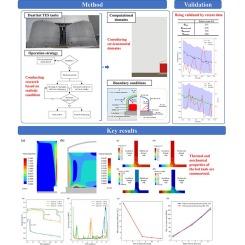Analysis of thermal and mechanical properties with inventory level of the molten salt storage tank in central receiver concentrating solar power plants
IF 6.1
2区 工程技术
Q2 ENERGY & FUELS
引用次数: 0
Abstract
Molten salt thermal energy storage (TES) tanks ensure steady power output of concentrating solar power (CSP) plants; however, recent tank failures have highlighted the need for further analysis. Current studies primarily focus on analyzing the molten salt flow, heat transfer, and thermal efficiency. Additionally, research on the latest tank structures is limited and lacks newest experimental validation. This study measures temperature and molten salt inventory levels in the high-temperature tank at a 50 MW central receiver CSP plant, connected to the power grid in 2019. A multi-physics model was developed to evaluate thermal and mechanical properties of TES tanks by combining computational fluid dynamics and finite element modeling using real plant data. Heat loss, temperature, displacement, and stress distribution of the tank at different inventory levels were investigated. Results show that ambient air velocity near the tank roof reaches 2.14 m/s, much higher than 0.2 m/s near the wall. The temperatures of inventory fluid and tank are close, varying slightly at different levels due to thermal conduction and radiation. Because the heat loss strongly depends on temperature, the total tank loss remains nearly constant across inventory levels. Larger temperature gradients and thermal stresses are primarily localized along the tank floor edge and the air-salt interface. Notably, the maximum thermal stress at the tank edge is three times higher than that at the interface. The magnitude of total stress changes by less than 5 MPa with and without thermal load, indicating that high temperatures exert only a minor impact on tank stress. In contrast, thermal load significantly affects tank deformation, particularly at the roof edge, where values exceed 150 mm. Despite the large variation in molten salt levels, tank wall temperatures and displacements present a minor change, suggesting a weak correlation with inventory levels. The findings obtained in this study provide important insights on the TES tank that could be used to optimize tank design and operation strategies.

中央集热太阳能电站熔盐储罐库存水平对热力学性能的影响分析
熔盐储热(TES)罐确保聚光太阳能(CSP)电站稳定输出功率;然而,最近的油箱故障突出了进一步分析的必要性。目前的研究主要集中在分析熔盐流动、传热和热效率方面。此外,对最新储罐结构的研究有限,缺乏最新的实验验证。该研究测量了2019年连接电网的50mw中央接收器CSP电厂高温罐中的温度和熔盐库存水平。通过结合计算流体动力学和基于真实工厂数据的有限元建模,开发了一个多物理场模型来评估TES储罐的热性能和力学性能。研究了不同库存水平下储罐的热损失、温度、位移和应力分布。结果表明:罐顶附近的空气流速达到2.14 m/s,远高于罐壁附近的0.2 m/s;由于热传导和热辐射的作用,库存液和储罐的温度接近,在不同的水平上略有不同。由于热损失很大程度上取决于温度,因此储罐的总损失在库存水平上几乎保持不变。较大的温度梯度和热应力主要集中在罐底边缘和空气-盐界面。值得一提的是,罐缘处的最大热应力是界面处的3倍。在有无热负荷的情况下,总应力的变化幅度小于5 MPa,表明高温对储罐应力的影响很小。相反,热负荷显著影响罐体变形,特别是在顶部边缘,其值超过150毫米。尽管熔盐水平变化很大,但罐壁温度和排水量变化不大,这表明与库存水平的相关性较弱。本研究获得的结果为TES储罐提供了重要的见解,可用于优化储罐设计和操作策略。
本文章由计算机程序翻译,如有差异,请以英文原文为准。
求助全文
约1分钟内获得全文
求助全文
来源期刊

Applied Thermal Engineering
工程技术-工程:机械
CiteScore
11.30
自引率
15.60%
发文量
1474
审稿时长
57 days
期刊介绍:
Applied Thermal Engineering disseminates novel research related to the design, development and demonstration of components, devices, equipment, technologies and systems involving thermal processes for the production, storage, utilization and conservation of energy, with a focus on engineering application.
The journal publishes high-quality and high-impact Original Research Articles, Review Articles, Short Communications and Letters to the Editor on cutting-edge innovations in research, and recent advances or issues of interest to the thermal engineering community.
 求助内容:
求助内容: 应助结果提醒方式:
应助结果提醒方式:


